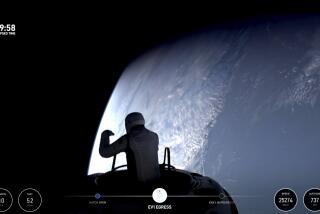Firms to Offer Private Moon Rocket Missions : Space: San Diego and Russian companies announce for-profit joint venture to launch robotic lunar payloads for about $57,000 a pound.
- Share via
SAN DIEGO — While the post-Cold War world beats swords into plowshares, a San Diego company and a Russian spacecraft manufacturer have joined to try to beat plowshares into profits by offering to launch private, moneymaking missions to the moon on idle Russian rockets for about $57,000 a pound.
Michael Simon, president of International Space Enterprises, said Wednesday there is enough interest among lunar scientists, astronomers and corporations to launch the first private moon orbiter in July, 1996, and the first private robotic moon lander in 1997.
In announcing their new venture at a science museum, Simon and other company officers said they did not yet have any paying customers and declined to identify potential clients who had shown an interest. But they said they expect to sign up their first customer within weeks.
International Space Enterprises has formed a joint-venture partnership with Lavochkin Assn., the recently privatized Russian company that produced space probes for the Soviet space program. The two companies plan to launch their first payload into lunar orbit on a Russian Proton rocket from the Baikonour launch facility in Khazakhstan.
Private companies are permitted under international treaty to launch spacecraft for profit and land on the moon and other planets. But Carl Q. Christol, a professor of international law at USC, said they must coordinate their activities with the country from which they launch their rockets. Under the 1967 Space Treaty, he said, so-called launching countries are responsible for private space ventures they host.
Simon did not say whether he has obtained clearances from the United States, where his company is based; Russia, where Lavochkin is based, or Khazakhstan. However, he said the only thing that could prevent a launch is a lack of customers.
“Lavochkin and us are committing to do it, if the customer base is there,” said Simon, a former NASA and General Dynamics engineer.
Several scientists said there is a market for sending experiments to the moon, since NASA recently declined to include any lunar experiments in its new series of low-cost Discovery Program planetary spacecraft. But they did not know if any experiments could be ready for launch by mid-1996.
Among the types of experiments Simon says his rocket could deliver to the moon are robotic lunar rovers, automated telescopes and devices for extracting oxygen, helium and other elements from the lunar surface.
“There is a lot of interest in something like this,” said planetary scientist Donald E. Shemansky, an aerospace engineering professor at USC. “The only problem is finding the funds to put the experiment packages together. . . . 1996 is not a lot of lead time.”
Shemansky earlier had proposed that NASA launch an 11-pound device that would let him analyze the moon’s thin atmosphere. NASA declined.
What is not clear is how the company proposes to retrieve data from the moon, and how much it might charge customers for this additional service. Simon and Valery Aksamentov, the company’s vice president of engineering, said the first mission will include a lunar-orbiting communications satellite that will relay signals to Earth from their customers’ experiments, but they did not say how the signals will be received and distributed on Earth.
More to Read
Inside the business of entertainment
The Wide Shot brings you news, analysis and insights on everything from streaming wars to production — and what it all means for the future.
You may occasionally receive promotional content from the Los Angeles Times.










